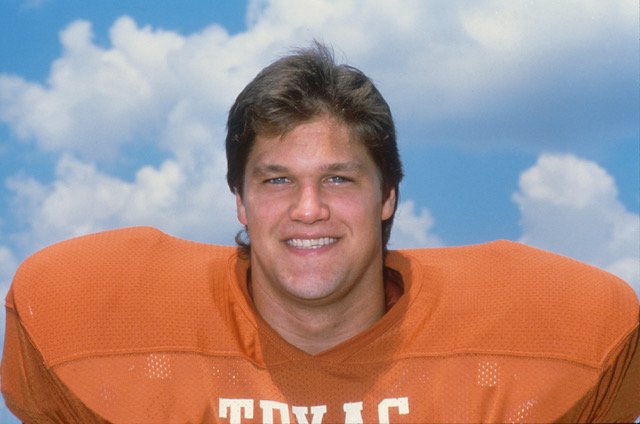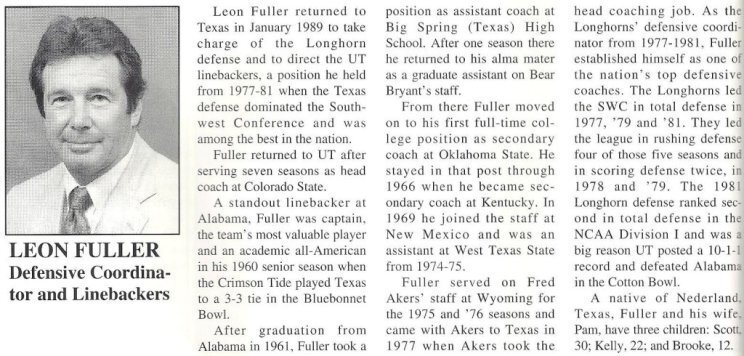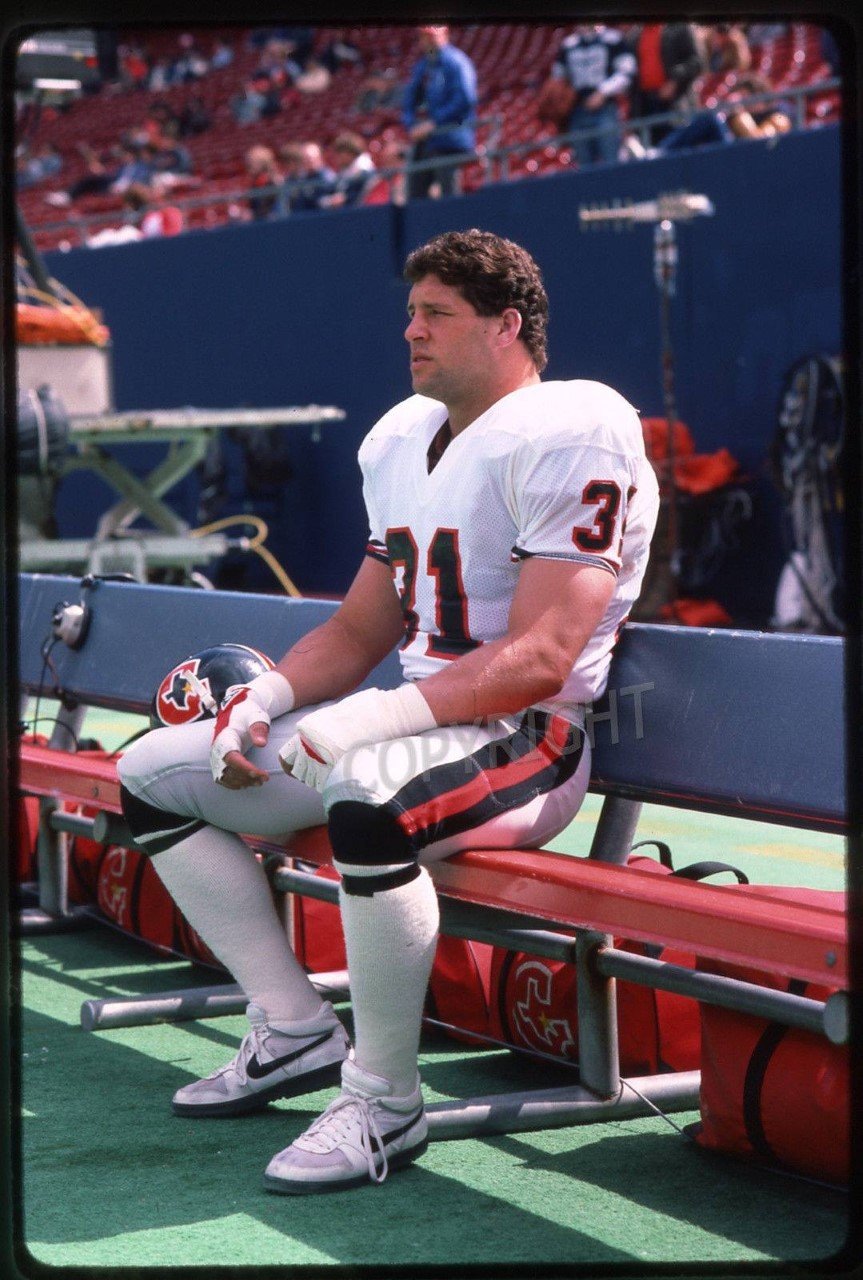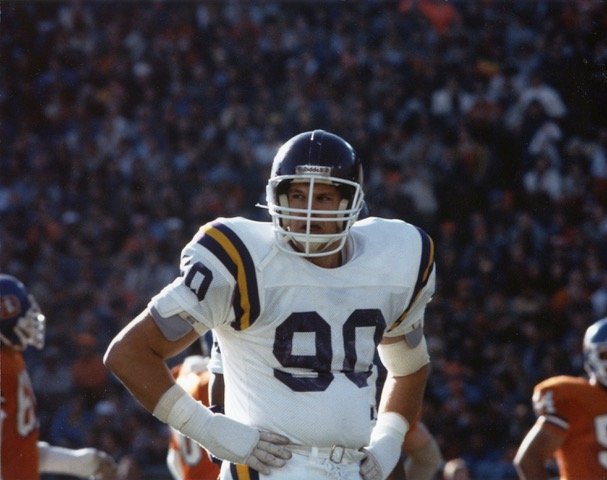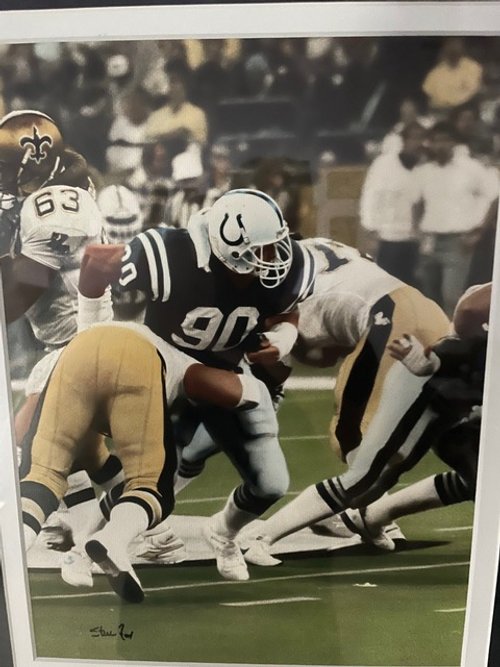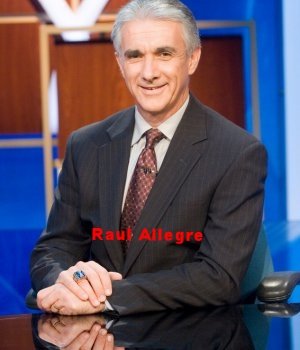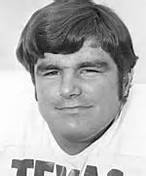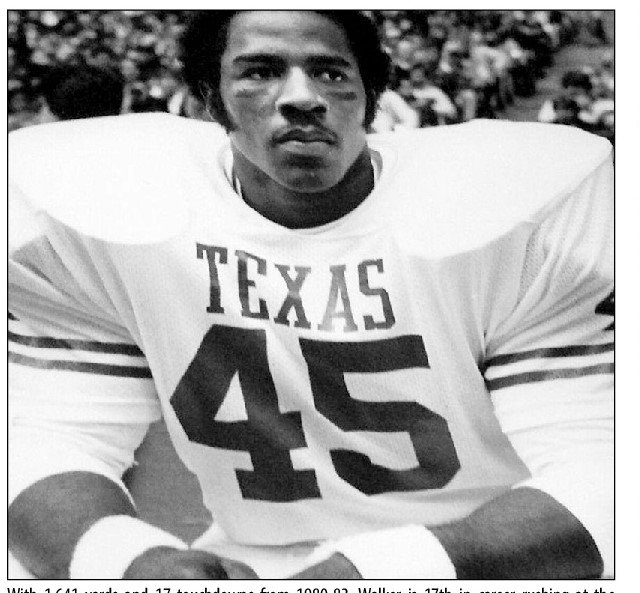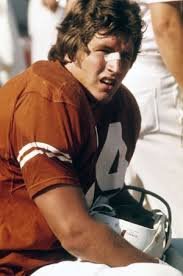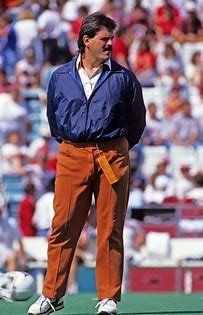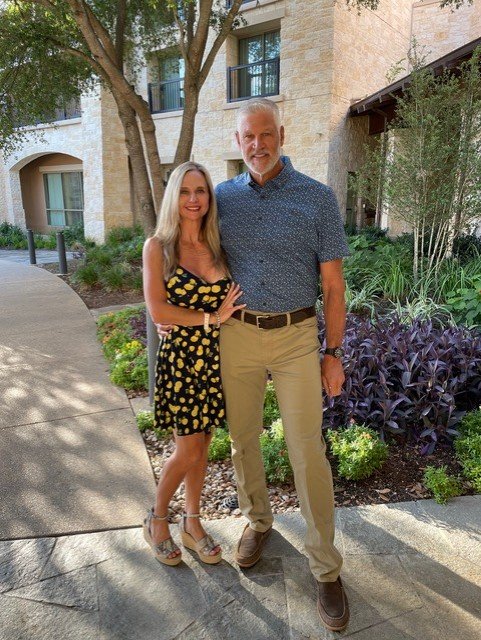John Haines
TEXAS DEFENSE 1983; JUST WAIT'LL WE GET OUR HAINES ON YOU
by Larry Carlson (lc13@txstate.edu)
At least for a quarter-century spanning the early 1960s through the mid-1980s, dominant defenses at the University of Texas were a constant on the college football landscape. By the '70s and certainly into the '80s, it was common even for good defenses to give up more yardage and points than previously due to more exotic offensive sets and an acceleration of speed as a prerequisite for skill players who handled the ball.
But speed and prowess on the other side of the ball mattered little to the Longhorn defenses of 1981-83, especially to the burly, surly one in the final season in that run that yielded a 30-5-1 record, two trips to the Cotton Bowl Classic and two top-five finishes. Those were the years when John Haines was part of the intimidating defenses crafted by head coach Fred Akers and assistants such as Leon Fuller, David McWilliams and Mike Parker.
The '83 unit backed its fierce reputation with consistency. It had star power in the form of not one but three All-America players in defensive backs Mossy Cade and Jerry Gray, along with big, brash middle linebacker Jeff Leiding, a Missouri boy who had played his high school ball in, of all places, Tulsa, OK.
Haines, at one tackle, helped anchor a line that also featured Austinite Eric Holle and future Lombardi Trophy winner Tony Degrate. Look back at individual game stats, and you'll find astonishing stats. In the SMU brawl, for instance, Degrate had eight solo stops and Haines had seven. And these were the guys fighting off initial blocks. Like the enduring underwear slogan from the brand named Hanes, the guy with a similarly spelled name -- teamed up with ten other terrors -- was wearing thin on Southwest Conference foes.
Scroll with arrow the three photos below.
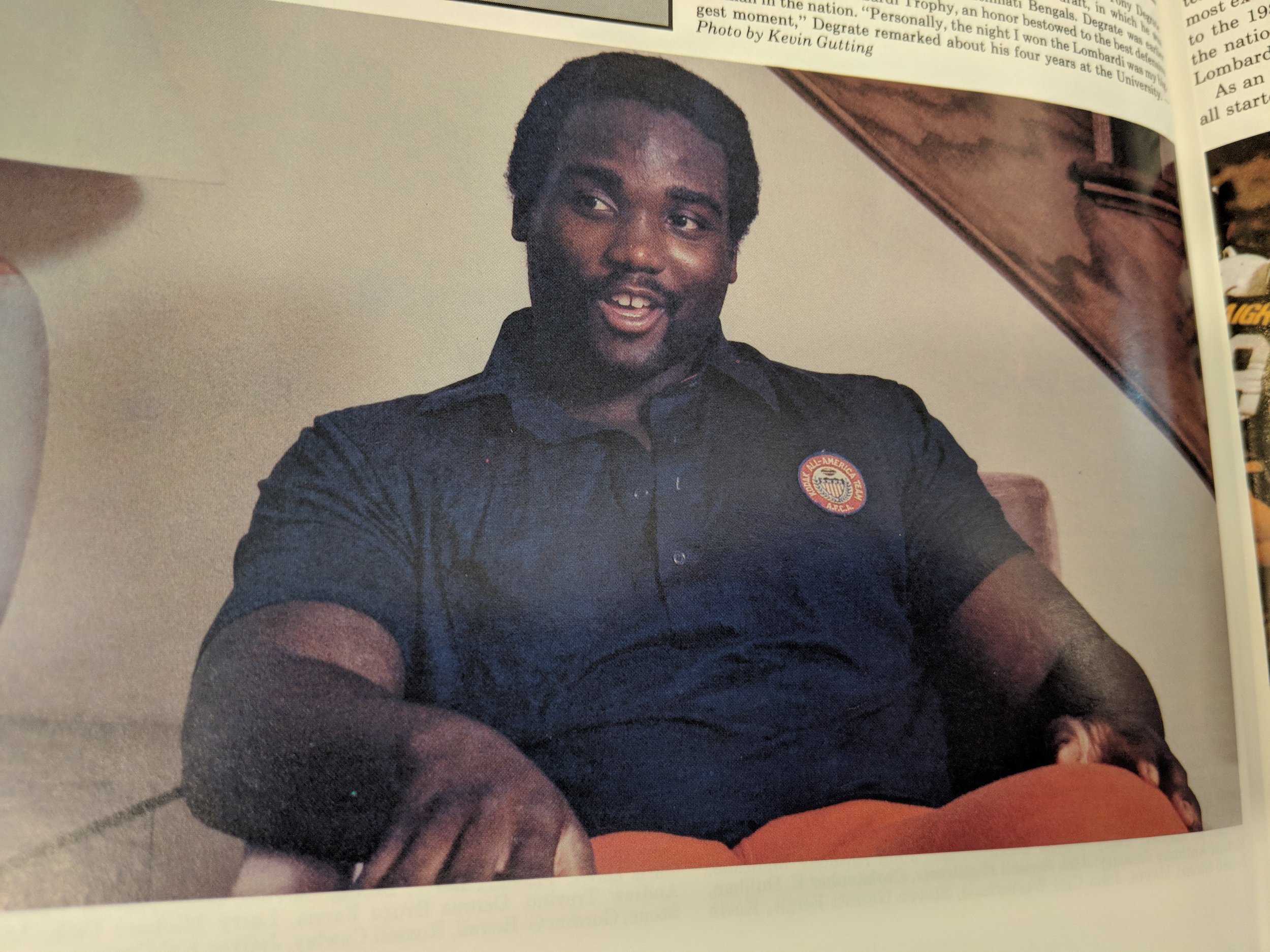
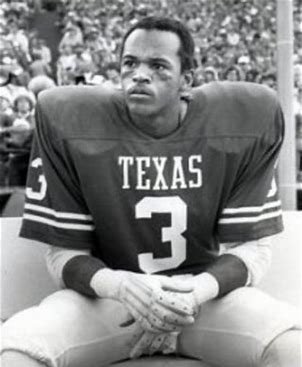
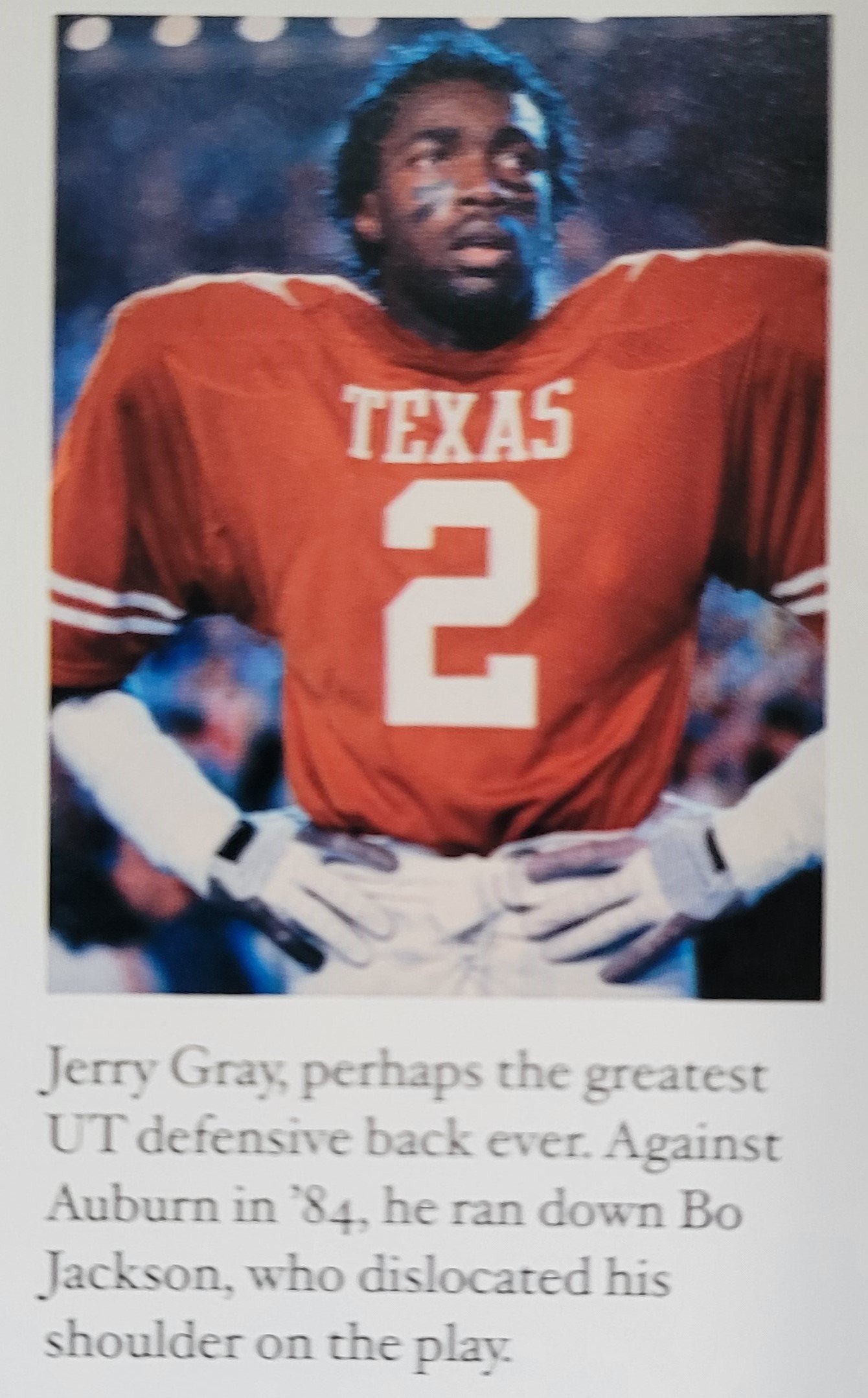
Only one of UT's first eight opponents, Oklahoma, scored two touchdowns. and that was in a 28-16 Texas victory. Only two other teams all year managed two puny touchdowns. The Horns gave up an average of fewer than ten points per game for the entire season.
Understand that 1983, the centennial year for The University, was a grand time at the Forty Acres. And, in spite of an unimaginative and low energy offense that often lived off the prowess and accuracy of freshman kicker Jeff Ward, Texas came within a "what if" of a perfect 12-0 campaign and a national championship. But the aforementioned SMU game should serve as "Exhibit A" when the jury scrutinizes why Texas was perhaps doomed to end its season in defeat. The 15-12 win over the Mustangs in Irving was highlighted by five field goals from Ward. No touchdowns provided by the offense. The Houston game, a 9-3 triumph, was similar.
The defense, then, led the way throughout the perfect regular season. Haines, like all his "stop 'em" cohorts, was riding high. humbling another offense each week, enjoying nights off in Austin, challenging for a national title and awaiting the NFL draft. Haines, scouted as one of the top tackles in the country, would go on to become one of an mind-boggling ten UT defenders --- among a record 18 Horns overall -- taken in the draft the following spring. But before what he thought would become his final game at Texas, Haines went through a fateful final practice that would be his last as a collegian and would impact his football future.
The long, tall Texan (6-6, 260) would advance to professional football success and make perhaps even greater, more remarkable contributions as a leader among NFL Alumni. A proud father of three bright, talented and athletic sons, Haines got to watch two of them don the famed burnt orange Texas jersey. Big John continues to lead a proud, productive business and personal life and took time from a busy schedule to visit with TLSN for a most interesting and revealing interview.
Here is John’s Interview conducted by Professor Larry Carlson
John Haines at work at Texas
John Haines at work after Texas
TLSN:
What was your recruitment like coming out of Arlington Heights High in Fort Worth, and did you strongly consider any schools besides Texas?
JOHN: Bobby Warmack was the coach that recruited me. He recruited Turner Gill and me from the same High School. We were pretty much recruited by the same schools. (Note: Gill went on to a 28-2 record as starting QB for Nebraska)
All of the schools in the Southwest Conference at the time recruited both of us. In addition, there was Oklahoma, Nebraska, Notre Dame, Florida, and UCLA. I strongly considered Nebraska. They would have been my other choice. It was just a little too far away for my Mom to come to all the games.
TLSN:
You played under two excellent defensive coordinators in Leon Fuller and David McWilliams. How would you compare or contrast their coaching styles?
JOHN: Leon Fuller was the coordinator for most of my time at Texas. David McWilliams was the defensive ends coach when I was as a freshman. Then he moved to DC when Leon left.
Both were similar with a dry sense of humor, but Leon was the more intense of the two. Both were good teachers. I was moved to tackle my freshman year, and Mike Parker became my coach.
TLSN:
Your old teammate, Kiki DeAyala, had a mind-boggling 22.5 sacks in '82 when you were a junior. These days, he might be a Heisman candidate with those numbers. What do you recall about Kiki’s techniques and prowess?
KiKi
John: These days that's probably true. We used to kid Kiki about his height and his blockhead, but he knew how to use his quickness and leverage. He played outside of me on the right side. We all had great knowledge and preparation and just refused to lose. Kiki was tough and played hard all the time. He would study his opponents and know their weaknesses. He had a great year. The link to Kiki’s interview is at: https://texas-lsn.squarespace.com/kiki-deayala
TLSN:
The 1983 defense that you helped anchor was perhaps the greatest in UT history. What do you recall about the preparation and practice that made the unit so good? I mean, every defensive starter ended up getting drafted.
JOHN: What made that defense so good as we were all predominately seniors who had played a lot of football. We were big, aggressive, fast, and competitive as hell as a unit. Our front seven, including the linebackers, put a lot of pressure on opposing offenses, and you could not run the ball on us. We were number one in total defense that year from start to finish! Just a tremendous group of very talented players.
Only Tony Degrate and Jerry Gray started as juniors.
We knew how dominant we were, and being ultra-competitive, we just imposed our will on any opponent. We refused to be beaten and knew our offense would sometimes struggle to score points. We had to keep them from scoring, period. That was our mentality. The majority of our entire defense played in the NFL. We just knew we were better than anyone we played. Ed Williams took over for Kiki my senior year (and was drafted in the second round). Eric (Holle) was a fifth-year senior as well. Certainly the best defense I have ever been around or seen at that level. We just had a bunch of dogs on that unit that were all really talented!
TLSN:
When you had time for any blowing off of steam and having a little fun, what did you and your teammates do back then? Do you recall any particular Austin hangouts?
JOHN: As a group, we did know how to have some fun! During my first couple of years, they would still have all-campus parties at the Student Union. We visited several sorority Houses and frat parties during their rush weeks. "The Keg" off campus was still open and changed over to "Tricky Mic.” We used to go to the Scholz beer garden after games for all the free keg beer in the back, and then we'd go out after that.
Coach Dabbs
We had a little too much fun sometimes, as I remember Coach Dabbs having to deal with Law Enforcement on our behalf. We would go float the river in San Marcos from time to time as well, and took trips to Lake Austin and Lake Travis. Never missed a Thursday at the "Silver Dollar." What a place!
TLSN:
I was gonna ask about camaraderie, but I think you said it all. That was a "work hard, play hard" bunch. Your defense back then absolutely carried the team to that 11-0 start in '83. What do you recall about the fun and pressure of being in the national championship hunt?
Is there one particular win during your senior year that stands out?
JOHN: Yes, Our defense carried that team. We were dominant, for sure. Because all of us had been together for those four years, we were close as friends, and I believe that made us very close as a group. We had a ton of leadership on that team and did not need any motivation. Turn the lights on, and we were ready to play. I don’t think we really felt much pressure as we were ranked number two most of that entire year. We just knew we were going undefeated. The only real thought during the season was that if Nebraska went undefeated as well, we would not get to play them and my old high school teammate.
For me, the game that stands out was the A&M game. I played well (Haines was Defensive MVP) and had a couple of sacks. Rick McIvor came off the bench (throwing four TD passes in a 45-13 win after UT trailed 13-0), and we scored 45 points and blew them out.
TLSN:
We recently interviewed Jeff Ward. He said that the stunning season-ending loss to Georgia in the Cotton Bowl haunts him to this day. You have your own unique disappointment of that day. What are your memories of that very strange and disappointing finish to such a great season and to your senior class’s remarkable time at Texas?
The link to Jeff’s interview is at:
https://texas-lsn.squarespace.com/jeff-ward-1983-1984-1985-1986
JOHN: I was in a golf cart on the sidelines with a cast on my leg. It was certainly tough to watch. I agree. That game will likely haunt all of us for the rest of our lives. We were so much better than them, and they knew it as well. For me personally, it was extremely disappointing in that I didn't get to play in that game. I injured my knee that last practice before we left for Dallas. Coach Akers called a goal-line scrimmage at the end of practice because our intensity was lacking, and I was hurt on the third play. He called it off after that. I didn’t get to play in the two All-Star games I had been selected for, nor the bowl game. That cost me a lot of money in the draft. The draft took eight defensive linemen in the first round that year, and before my injury, I was rated fourth or fifth in that entire class. Truly heartbreaking for sure.
TLSN:
You were part of that record number of UT seniors drafted in the spring of '84 and went to the Vikings in the seventh.
JOHN: That injury killed my draft status but aside from that, I couldn't begin preparing until the cast was removed. When the Vikings drafted me they told me they were going to put me on the IR (injured reserve) immediately, until midseason. I didn't go to training camp, just rehabbed my knee. I was activated about week eight or nine and played the remaining games.
TLSN:
Minnesota lost more games your rookie season than UT lost in your four years. What was it like, adjusting to professional football with the Viks, then the Colts?
JOHN: The NFL had been a lifelong dream of mine and it was great to see that come true. The NFL is definitely a different experience than college. You quickly realize this is a job. I spent the first half of my rookie year on IR and worked to get back healthy and back in shape. The NFL has a lot of very talented players; no scrubs up there.
That first year was really frustrating in that I was not use to losing so much. The head coach was Les Steckel, and he really overworked the team during training camp. He had a lot of veteran players, and they were not used to that, so when the season began, we had a lot of injured players. We won three games that year, and they fired him after the last game. Bud Grant was rehired the following year.
Unfortunately, you do see that some players get used to losing and don’t always play hard all the time. It’s easy to see.
I was signed by the Colts the following year. I enjoyed my time in Indianapolis, although we were always middle of the pack in the AFC East. We couldn’t seem to beat Miami (Dan Marino) or the Bills ( Jim Kelly). They were both really good. We had a pretty good team, just not enough offense for that division.
TLSN:
What's the overall summation of your time in the NFL?
JOHN: I enjoyed my four years in the league; it was frustrating in that we were never in the hunt for a championship, and I hated all those losses. It didn’t sit well, and I wasn’t used to it. There were no practice squads, and durability was key. You stayed out of the training room and just had to treat yourself. I played my second year with a broken wrist for the remaining six games and would shoot it up before every game.
We did have the strike in '87, which made that year interesting. Got in the playoffs but had to go to Cleveland and play in the "dog pound," which ended our season. I made a lot of friends and would have played a few more years probably but dislocated my shoulder in my fourth year, which effectively ended my career. Sat out a year, got back in shape but flunked three physicals for teams that had offered me contracts. Once that happened, the whole league knew. It was time to move on and head back to Austin.
TLSN:
How tough was it to leave football, and what kind of work did you land in when you hung up the cleats?
JOHN: It was tough initially. I wasn’t sure what I wanted to do career-wise but initially fell into Commercial Real Estate. Did that for a few years during the S&L failure, which made that business extremely tough.
I was contacted by Dell about coming to work for them in sales, and that was my entrance into the technology world. I have stayed in that industry for the remainder of my career. I wish I could have stayed in real estate, but it has all worked well. No reason to look back now.
Images of some Longhorn players at a reunion honoring Coach Akers.
At a party for Akers -Lawrence Sampleton, Mike Chapman, Eric Holle, Mike Babb, John Haines. 6’4” is the short one in this photo
A slide show is below
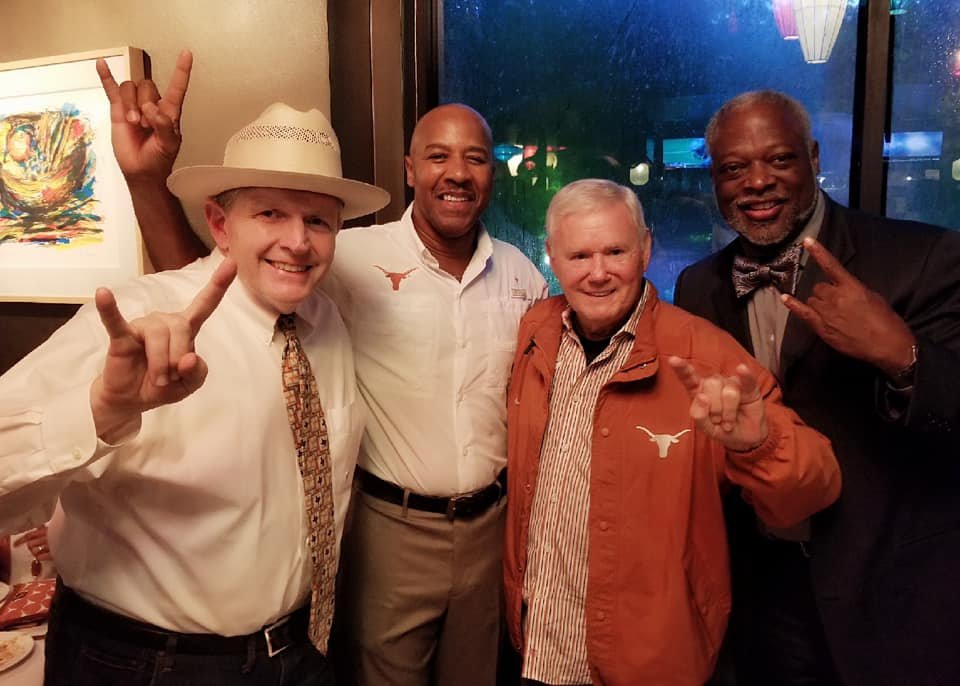
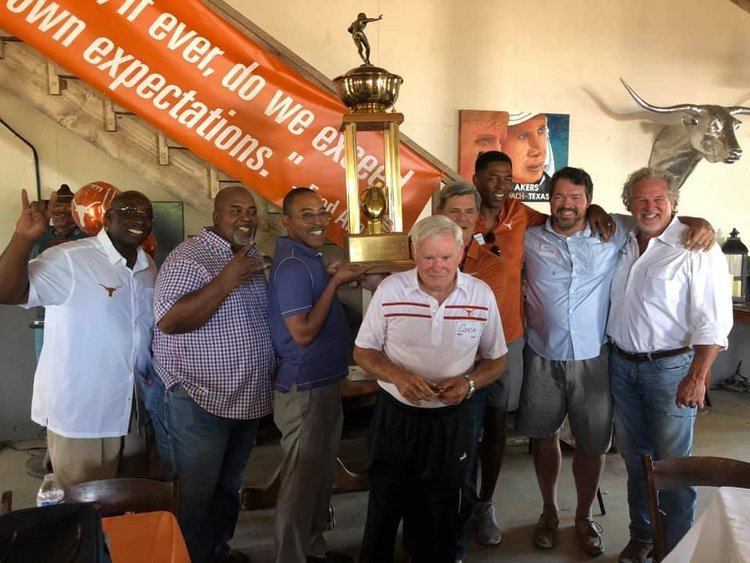
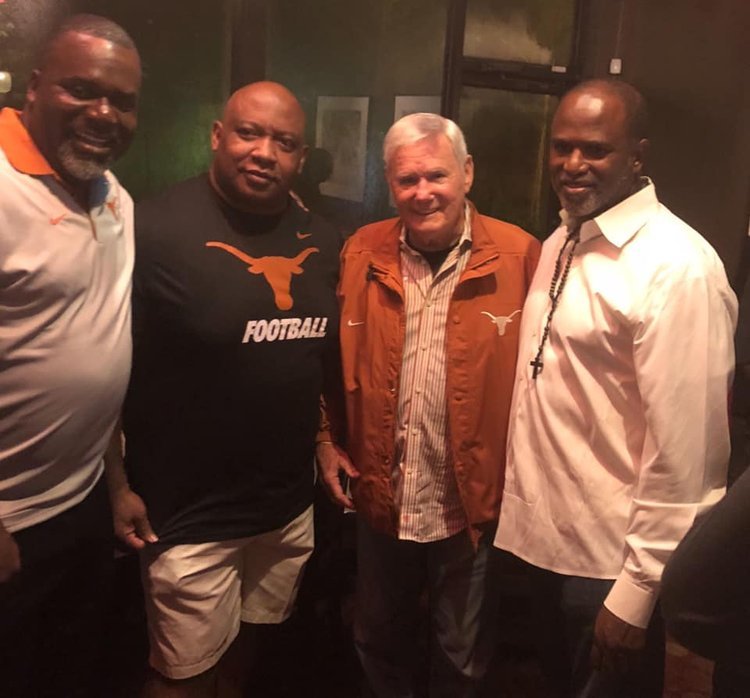
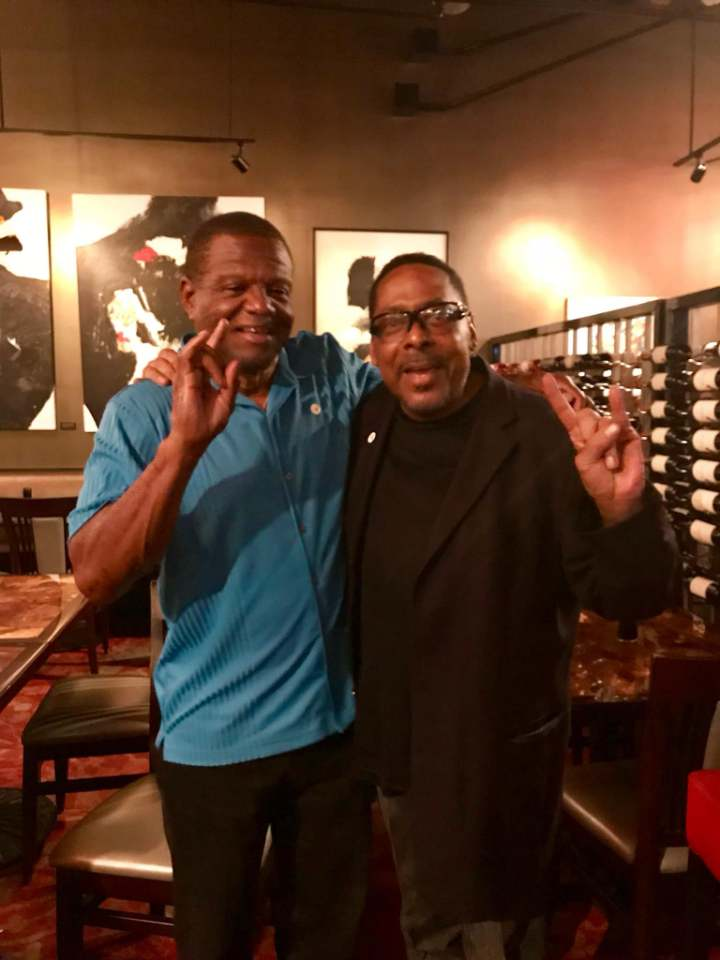
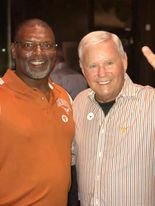
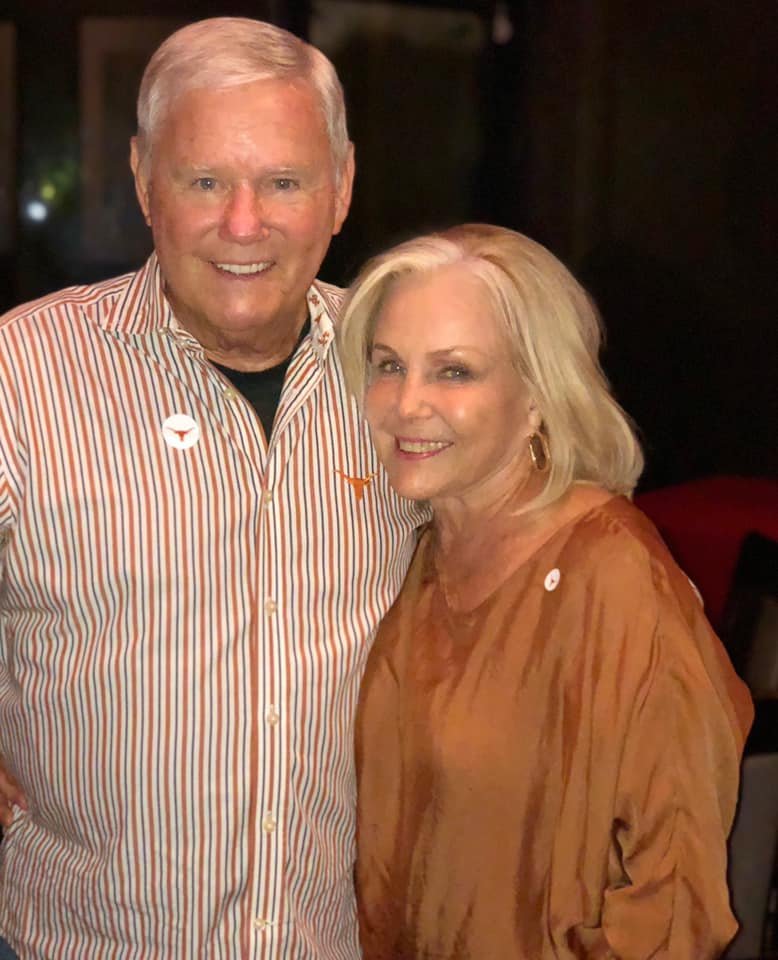
TLSN:
You've been very active in the Austin chapter of the NFL Alumni Association, serving as president for many years. How rewarding has that been? Who are some other guys who are also involved?
JOHN: It has been an absolute pleasure serving as President of the NFL Alumni Chapter here in Austin and serving on the National Board for four years. Our chapter here in Austin is one of, if not the most successful chapters in the country, while not being in an NFL city. Our leadership over the years has been a big part of that success. Our mission has always been “Caring for Children,” and we have donated more than $2 million dollars to the Austin community over the years.
We began with Jerry Sisemore leading the charge, as well as others like Doug English. Raul Allegre, William Graham, and Johnny Walker are from my era of teammates. Other teammates who are still involved are Bobby Micho, Eric Holle, Ray Woodard, Kenneth Sims (strength and conditioning coach) Dana LeDuc, and others. A great group of men who don’t mind giving back with their time. The great thing is we now have some younger guys involved who are leading the organization. I'm still on the Board locally, so I participate when I can.
TLSN:
A lot of Longhorn fans know that you have three sons and that two of them -- Dakota and Dylan -- played for Texas this past decade. How much of a “football Dad" were you as the boys grew up?
JOHN: I was very much a Football Dad but didn’t necessarily push them into any one sport. They were all really good athletes growing up, I coached the majority of their recreational teams in football, baseball, and basketball and really enjoyed that part. They played everything, including soccer and running track. Their mother ran track at UT, which helped, too. She was competitive as well. I look back on those times; it was great to see them grow athletically and personally during those years. It was really great being their Dad! we had a lot of fun and still do.
TLSN:
How competitive were the kids with each other?
JOHN: Extremely competitive were Dakota and Dylan. Derek was a little later in time but also very competitive. They always wanted to outshine each other, which made it difficult at times as well.
TLSN:
What were the kinds of things you tried to instill in them, utilizing your experience? Were you tough or laid back as a father and mentor?
JOHN: Toughness, dedication, and hard work towards improving your skills were big things in our family. We wouldn't let them quit a sport once they began. We spent a lot of time off the field working on improving their skills. They were all really good players in every sport growing up, just gifted athletically, and we won a lot as well, which made it fun. I would say I was pretty tough on them because I knew what they were capable of.
I guess fathers are generally tougher on their own. Most children naturally figure out what they are good at and which sport they like best. They played all the major sports through (Lago Vista) High School. We just went from one season to the next. Dakota was a great baseball player through high school. Dylan gravitated to football, and Derek went to state in golf three straight years. Tried to get him to play in college.
TLSN:
How would you describe the pride and satisfaction you felt, seeing Dakota and Dylan suit up for the Horns?
JOHN: Obviously, pride and satisfaction was an understatement, seeing them suit up for the Horns. Both of them were walk-ons, only recruited by smaller schools coming out of high school. Dakota walked on under Mack Brown and unfortunately injured his knee and never really recovered after that. They moved him to wide receiver. He should have stayed at defensive back and never really got the chance for a starting job after returning from his injury.
Charlie Strong showed up after Mack’s departure and since they didn’t know any of these players or recruited them, Dylan had an opportunity. They wanted the best eleven they could find. Vance Bedford was a teammate of mine and was Defensive Coordinator. He called me and said he couldn’t believe that they had never really looked at him.
That spring, he moved into the starting role and never looked back. Started three years and is fifth all-time in school history in interceptions! Quite a career, and a really good player. Great instincts, smart, and a great athlete. It was truly a blessing getting to watch them both play.
I wish Dylan would have been given an opportunity to play in the NFL; he would have done well. I know his ability, and he would have excelled at that level.
Just like at any level, some organizations just don’t know what they're doing, and that's why they never win or have success.
A salute from his 3 sons
Dakota, John, Dylan, and Derek Haines
Derek Haines
From the very first time I ever played sports my father has always been right by my side. Whether he was coaching or in the stands cheering, he has always been the most supportive person in my life. I remember growing up, he made sure to do his best to lead my brothers and I towards being the best person we could possibly be. Together, we share so many great memories but some of the best ones are still being made to this day. There is nothing I look forward to more than playing golf with him every Sunday that we can. Love you pops, next round is on me.
Dylan Haines
One of my favorite memories was probably when my Dad coached my 6th-grade pop warner football team. It was my first time ever playing tackle football, and getting to have him as a coach made it one of the best experiences of my life. He always pushed me to give anything I did 100%, and because of that, I was able to excel in football through high school and eventually get to play at UT, which I know made him very proud. I would've never made it to that level if not for him.
Dakota Haines
Dakota Haines- athletics have been such an important part of my family's life and my life that there are just too many. One that sticks out to me isn't necessarily a "happy" or "proud" moment in my life but one that definitely shaped me. My dad was coaching my little league team, and I was pitching in one of the playoff games towards the end of the season. I remember us basically playing to finish first or second in the league, and in about the third inning, my teammates in the field kept making errors after errors which allowed multiple runs to score, and gave up our lead.
Dakota continues with his story: I remember being so frustrated on the mound that I was nearly on the verge of tears. After we finally got the third out, I stormed off the field in disgust and threw my glove over the fence and into the parking lot. My dad swiftly told me to go sit on his tailgate in the parking lot, where I sat for the rest of the game as I watched our team fight back and win. I think this moment of pure shame and embarrassment made me a better teammate and taught me a lot about being mentally tough and how big of an impact it can have in sports. There's no question that sports wouldn't have played as big of an impact on my life if it wasn't for my Dad. He's been an amazing role model to follow in both athletics and business but continues to be an even better father.
TLSN:
What kind of work have you been involved with in recent years, and what keeps you busy these days?
I have also been in a wonderful relationship with Lisa Farrens for the last year and a half, and that has truly been a blessing. I am grateful for her and what we have together.
JOHN: I have been in the Technology industry over the last 25-plus years, working for different companies along the way. Raising three sons has kept me busy for a lot of those years, and I'm looking forward to spending time with my grandkids someday. They are all doing well here in the Austin area, and I often see them. I live out on Lake Travis, and they come out quite often to surf on my boat with their friends. It's a lot of fun, and we enjoy playing golf together and taking vacations together.
TLSN:
How much interest do you have in UT football these days? Any expectations for this fall after last season’s 5-7 record?
JOHN: I would say quite a bit. I've been on the Longhorn Foundation for 30 years and have had the same season tickets during that time. I usually attend all the home games and will watch when they're away if possible. Last year was probably the toughest year I can ever remember watching the Horns play. I was glad when the season was over.
The lowest I have ever seen in this program. It was tough watching them play and giving up leads in the second half. Just no killer instinct and desire not to lose. Sark has had some tremendous success in recruiting, and I just hope it translates on the field. It seems like a lot of these kids never improve during their time here, which isn’t good. They need more linemen on both sides of the ball for this team to improve. Somewhere along the way, this program stopped recruiting really good linemen. The game is still won up front, and they have to improve there for this team to have success.
TLSN:
What are your opinions about the NIL situation in college ball? Texas RB Bijan Robinson is driving a Lamborghini and potential starting QB Quinn Ewers has an Aston Martin, the James Bond car.
In your days at Texas, the flashy cars would've gone to the defensive hosses. What were you driving back then, John? What would have been your “NIL dream car?"
JOHN: Personally, I don’t believe it's a good situation for college athletics. I understand the concept of all the money in college athletics, but 18-to-20-year-old kids won’t do well with that kind of pressure. Like the NFL, there will be some who receive more, some less, and I wonder what kind of team chemistry and culture that will create. In our days, we would have gotten a ton of money to play. We didn’t care about that and were probably better off that we didn’t. I drove a Buick in college, the only thing I could afford. The hot cars during my time would probably have been a Trans Am or Corvette, although I probably could not have fit into a Vette! Likely would have been better off with a new truck instead. My first new car was a Blazer with a custom paint job I bought my rookie year in the NFL.
TLSN:
What's on the horizon for you, whether it's an upcoming vacation, a new business venture, involvement in whatever, retirement, etc?
JOHN: I'm still in the technology industry, working in sales leadership roles. I would like to work for six to eight more years, then retire, and ride off into the sunset. I'm still very active physically. I enjoy golf, surfing on the boat, snow skiing, and traveling. I'm still looking at new business ventures and investing in real estate and want to remain active in retirement. Perhaps some type of local mentoring and coaching role might also be in order.
TLSN:
We usually end these interviews with this: What is it about you that most people wouldn’t know about John Haines?
JOHN: Well, that's an interesting question…..I'm trying to learn to play the piano. My Mother played quite well, and I miss her playing on the holidays. I wish I would have let her teach me when I was young.
One other weird fascination is I like to try and learn different styles of dances. Go figure. Working on learning the country swing dance.
Professor Carlson interviewing Coach Akers
Other links to articles, podcasts, or interviews with Longhorn players during the Aker’s years
https://texas-lsn.squarespace.com/alan-champagne-1984-1988
https://texas-lsn.squarespace.com/larry-carlson-brad-shearer
https://texas-lsn.squarespace.com/robert-brewer
https://texas-lsn.squarespace.com/herkie-walls
https://texas-lsn.squarespace.com/kenneth-sims
https://texas-lsn.squarespace.com/rick-mcivor

